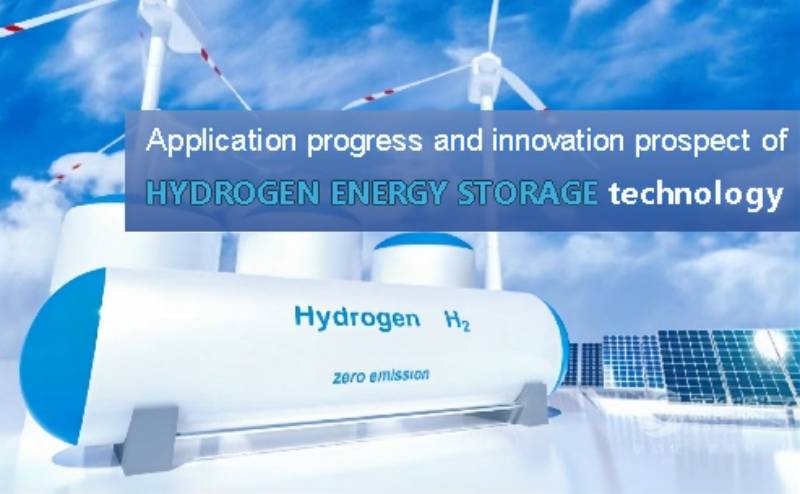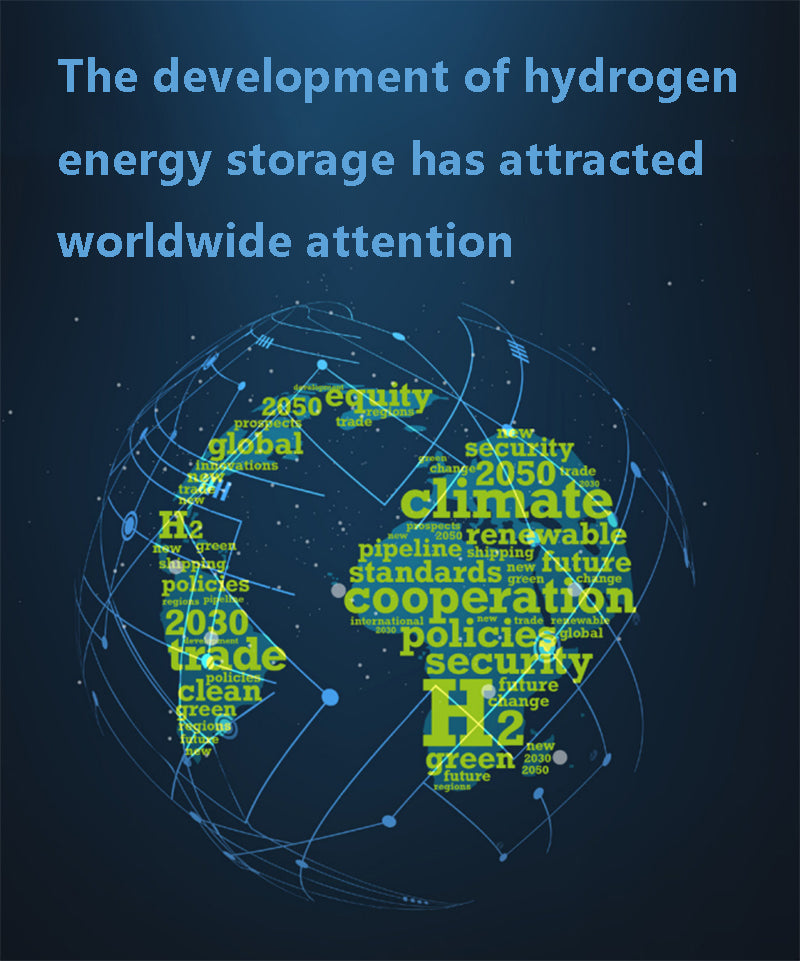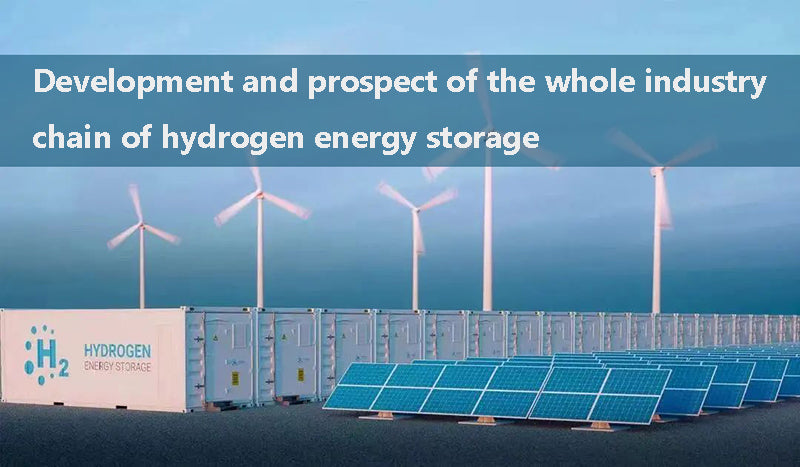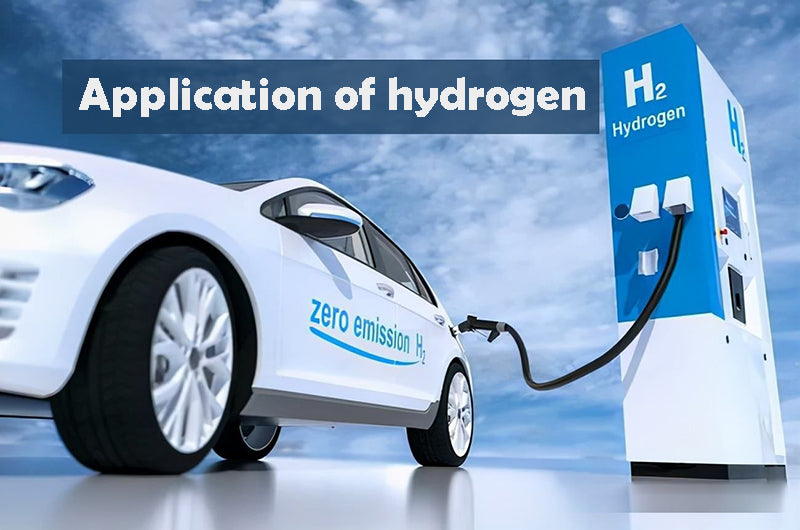
Main content:
Hydrogen energy storage is an important technology to help consume a high proportion of renewable energy, promote the transformation of the energy structure, and achieve the goal of carbon neutrality. It is necessary to strengthen scientific research, promote the technological progress of the whole industry chain of hydrogen energy storage, and accelerate the large-scale application.
1. The development of hydrogen energy storage has attracted worldwide attention
Hydrogen energy is a flexible, clean, and zero-carbon secondary energy that can be stored and transported on a large scale, enabling long-term and even inter-seasonal energy storage. At present, many countries (regions) in the world have issued relevant policy documents to accelerate the development of the hydrogen energy storage industry. The United States regards hydrogen energy as the core link for the integrated development of the energy system across fields, and supports it in the energy law and related policies.
Relevant US documents pointed out that by 2050, hydrogen energy will account for 14% of final energy consumption in energy storage USA and contribute 16% of CO2 emission reductions in the US industrial sector. Japan actively develops the hydrogen energy economy in the manufacturing and energy industries, and promotes the construction of a hydrogen energy storage society from a national strategic level. The EU actively promotes the development of hydrogen energy storage, and regards hydrogen energy as an important guarantee for energy security and energy transformation, as well as an important path to achieve carbon neutrality.

The relevant documents issued by the EU all propose that under the 2050 carbon neutral vision, the proportion of hydrogen energy in energy consumption will increase to 13-14%. China also attaches great importance to the development of the hydrogen energy industry. The China Hydrogen Energy Alliance predicts that in 2060, hydrogen energy will account for 20% of China's energy-using terminal energy system, and the annual consumption will reach 130 million tons.
2. Hydrogen energy storage is a strong support
Construction of new power system. Hydrogen energy and electrical energy can be mutually transformed through key technical links such as electricity hydrogen production, hydrogen addition/sale, hydrogen power generation/heat, and large-scale hydrogen carrier production. Based on this, hydrogen and derived gases can realize large-scale long-cycle hydrogen energy storage under the condition of ensuring economical efficiency, the storage scale is from 100 kilowatts to gigawatts, and the storage time is from hours to seasons.

Therefore, the development of hydrogen energy storage will help to achieve a high proportion of large-scale renewable energy consumption in China, improve the utilization efficiency of renewable energy, and effectively support the construction of new power systems.
3. Development and prospect of the whole industry chain of hydrogen energy storage
Continuous research on the "production, storage, transportation, and use" of the entire industry chain of hydrogen energy storage will promote rapid technological progress and large-scale application.
① Preparation of hydrogen
Green hydrogen (hydrogen produced from renewable energy sources) is at the heart of supporting the development of hydrogen energy storage and achieving the goal of carbon neutrality. It is necessary to further reduce the production cost of green hydrogen and obtain a competitive advantage in terms of economy. Renewable power water electrolysis hydrogen production technology can be divided into:
● Low temperature region technology (25-100℃): alkaline water electrolysis is a mature technology for large-scale production of green hydrogen, which has been commercialized on a large scale, and the hydrogen production rate can reach more than 1000Nm³/h. Proton exchange membrane water electrolysis is a rapidly developing small-scale green hydrogen production technology, which has achieved small-scale commercial application, but this technology relies on precious metals and is costly.
● Medium temperature region technology (100-600℃): Medium temperature water electrolysis technology is an electrolysis technology with broad development prospects. However, it is still in the development stage of developing electrolyte materials with H+ and OH- conductivity.

● High temperature region technology (above 600℃): The solid oxide water electrolysis technology has excellent performance, and the product components are flexible and adjustable. It is expected to synthesize hydrogen carriers such as alkanes, alcohols, and ammonia in one step.
② The storage and transportation of hydrogen
● Low-temperature liquid hydrogen storage: simple and safe storage and transportation, with a small volume ratio. However, the hydrogen liquefaction process has high energy consumption, large volume of the container, and liquid hydrogen is easily lost by volatilization.
● High-pressure gas hydrogen storage: mature technology, simple structure, low energy consumption for compressed hydrogen preparation, and fast hydrogen filling and discharge. However, the hydrogen storage capacity of this technology is small, and the safety performance needs to be further improved.
● Hydrogen storage materials: safe technology, high hydrogen storage density, convenient transportation, low cost, and potential for development. The theoretical hydrogen storage capacity is large, and the technical maturity needs to be improved.
③ Application of hydrogen
Hydrogen can be used in proton exchange membrane fuel cells, solid oxide fuel cells, hydrogen gas turbines, hydrogen internal combustion engines and many other power technologies. At present, the renewable power hydrogen energy storage system is developing in the direction of electricity-heat-hydrogen co-production on the one hand, realizing multiple collaborative storage, and improving the energy efficiency and fluctuation adaptability of the system.
On the other hand, hydrogen energy storage is developing towards modularization and compactness, flexibly meeting the needs of users in multiple scenarios, taking into account economy, efficiency and safety. In the future, on the premise of improving the economy of green hydrogen, it is necessary to further develop production, storage and transportation, and application technologies, vigorously promote the power-hydrogen transmission and distribution coordination of renewable energy, and continuously increase the proportion of green hydrogen in energy consumption terminals.

In addition, it can also take advantage of the fuel cell vehicle industry chain to guide the development of hydrogen energy storage, fuel cells, and hydrogen-based heat engine combined cooling, heating and power systems. And develop hydrogen energy storage and energy supply systems of different scales suitable for important application scenarios such as home energy storage, commercial buildings, data centers, and independent microgrids, and comprehensively promote the development of low-carbon hydrogen energy.
Related articles: top 10 home energy storage battery companies, flywheel energy storage, top 10 energy storage lithium battery companies
















